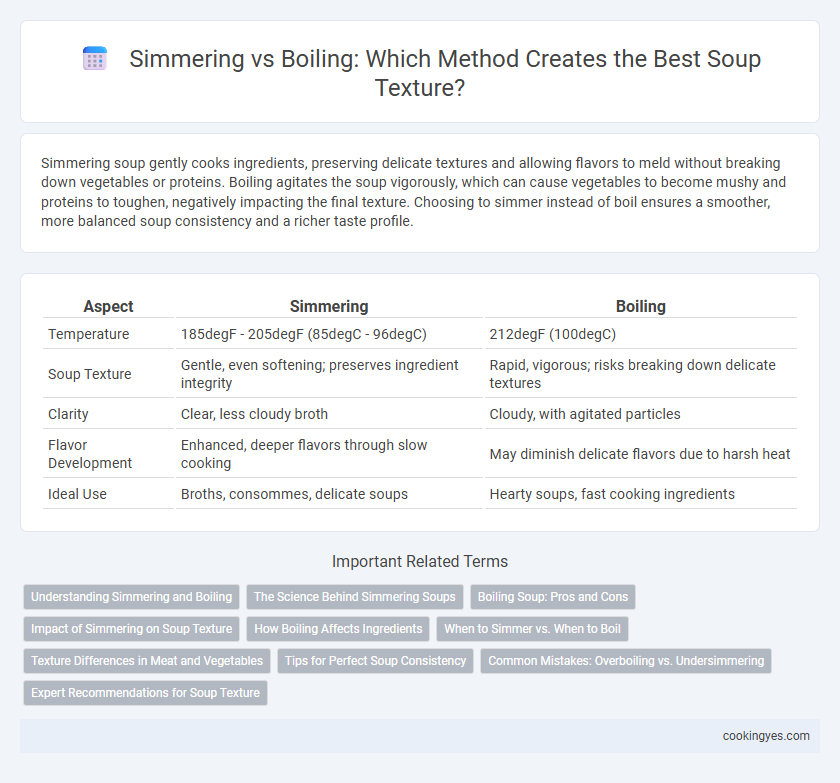Simmering soup gently cooks ingredients, preserving delicate textures and allowing flavors to meld without breaking down vegetables or proteins. Boiling agitates the soup vigorously, which can cause vegetables to become mushy and proteins to toughen, negatively impacting the final texture. Choosing to simmer instead of boil ensures a smoother, more balanced soup consistency and a richer taste profile.
Table of Comparison
| Aspect | Simmering | Boiling |
|---|---|---|
| Temperature | 185degF - 205degF (85degC - 96degC) | 212degF (100degC) |
| Soup Texture | Gentle, even softening; preserves ingredient integrity | Rapid, vigorous; risks breaking down delicate textures |
| Clarity | Clear, less cloudy broth | Cloudy, with agitated particles |
| Flavor Development | Enhanced, deeper flavors through slow cooking | May diminish delicate flavors due to harsh heat |
| Ideal Use | Broths, consommes, delicate soups | Hearty soups, fast cooking ingredients |
Understanding Simmering and Boiling
Simmering soup involves cooking it gently at temperatures just below boiling point, typically between 185degF and 205degF, which helps preserve delicate ingredients and develop complex flavors without breaking them down. Boiling reaches 212degF and agitates the soup vigorously, causing faster cooking but often leading to tougher textures and cloudy broth due to ingredient agitation and emulsification. Understanding the temperature control in simmering versus boiling allows for optimal texture and clarity in soup preparation, essential for achieving desired mouthfeel and flavor balance.
The Science Behind Simmering Soups
Simmering soups at a temperature just below boiling, typically around 185-205degF (85-96degC), allows collagen and connective tissues in ingredients to break down slowly, resulting in a richer, silkier texture. The gentle heat prevents proteins from toughening and starches from overcooking, preserving the clarity and mouthfeel of the broth. Scientific studies show that maintaining this precise temperature enhances flavor extraction while minimizing nutrient degradation, creating a balanced and flavorful soup.
Boiling Soup: Pros and Cons
Boiling soup rapidly cooks ingredients and extracts strong flavors, making it ideal for quick meals or hearty broths. However, intense boiling can break down delicate vegetables and proteins, leading to a cloudy broth and mushy texture. Simmering preserves the clarity and texture, but boiling offers a faster method to develop robust taste profiles in soups.
Impact of Simmering on Soup Texture
Simmering soup gently cooks ingredients at a temperature just below boiling, allowing flavors to meld and textures to soften without breaking down delicate vegetables or proteins. This controlled heat preserves the integrity of ingredients, resulting in a richer, smoother mouthfeel and a more balanced, well-developed taste profile. Boiling, in contrast, can cause tougher fibers to toughen and ingredients to disintegrate, leading to a harsher texture and less refined soup consistency.
How Boiling Affects Ingredients
Boiling soup causes vigorous bubbling that breaks down delicate ingredients, leading to a softer, sometimes mushy texture. High heat from boiling can cause proteins to toughen and vegetables to lose their shape and nutrients, negatively affecting the overall consistency. Simmering at a lower temperature preserves the structural integrity and flavors of ingredients, ensuring a balanced and richer soup texture.
When to Simmer vs. When to Boil
Simmering soup at a low, steady temperature between 185degF and 205degF preserves delicate ingredients like vegetables and seafood, allowing flavors to meld without breaking down textures. Boiling, characterized by vigorous bubbles at 212degF, is ideal for quickly cooking tough ingredients such as beans, bones, or large cuts of meat, aiding in extracting rich flavors and gelatin. Choosing to simmer or boil depends on the soup's ingredients and desired texture, ensuring tender solids and a well-developed flavor profile.
Texture Differences in Meat and Vegetables
Simmering soup maintains tender meat fibers and preserves the integrity of vegetables, resulting in a smooth, velvety texture ideal for broths and stews. Boiling, with its higher temperature and vigorous agitation, often causes meat to become tough and vegetables to break down rapidly, leading to a coarser, less refined texture. Choosing simmering over boiling significantly enhances the mouthfeel and consistency of ingredients in soup.
Tips for Perfect Soup Consistency
Simmering soup at a low, steady heat preserves delicate ingredients and enhances flavor fusion, resulting in a smoother, richer texture compared to boiling. Boiling can cause proteins to toughen and vegetables to break down excessively, leading to a watery or grainy consistency. For perfect soup texture, maintain a gentle simmer, stir occasionally, and adjust seasoning as ingredients soften to achieve balanced thickness and depth.
Common Mistakes: Overboiling vs. Undersimmering
Overboiling soup often results in broken vegetables and toughened proteins, diminishing texture quality and flavor balance. Undersimmering leaves ingredients undercooked, causing uneven textures and a less integrated taste profile. Maintaining a steady simmer between 180degF and 205degF is essential for optimal soup consistency and nutrient retention.
Expert Recommendations for Soup Texture
Expert recommendations emphasize simmering soups to preserve delicate ingredients and achieve a smooth, balanced texture, as high heat from boiling can cause proteins to toughen and vegetables to break down unevenly. Simmering at a gentle, consistent temperature allows flavors to meld gradually, resulting in a richer, more harmonious taste profile. Professional chefs suggest maintaining a temperature just below boiling point, around 185-205degF (85-96degC), to optimize soup texture and overall quality.
Simmering vs Boiling for soup texture Infographic

 cookingyes.com
cookingyes.com